#Gunma Prefecture
Explore tagged Tumblr posts
Text


2024.8.4 尾瀬 夏が来れば、思い出す 至仏山 Mt.Shibutsu
224 notes
·
View notes
Text





伊香保・洋風旅館 ぴのん ∣ You-fu Ryokan Pinon・Ikaho (2) (3) (4) (5) by Iyhon Chiu
#at the table#chairs waiting#morning light#window view#stained glass#inside a room#ryokan#golden light#japan#gunma prefecture
9 notes
·
View notes
Text

EF65-2085
36 notes
·
View notes
Text
Japan removes monument for Korean forced labor victims despite criticism
By Yi Wonju
TOKYO, Feb. 1 (Yonhap) -- A Japanese local government has taken down a memorial stone for Korean victims of Japan's wartime forced labor at a public park earlier this week despite opposition from activist groups.
Authorities from Gunma Prefecture began pulling down the stone on Monday and finalized the removal on Wednesday, Japan's Asahi Shimbun newspaper reported the next day.
Aerial photographs taken by the news outlet showed the remains of what appeared to the base of the memorial stone smashed into pieces at the site.
The authorities are said to have spared the epitaph of the stone and handed it over to a civic group handling the memorial stone, before tearing down the concrete wall.
The phrase, "Remembrance, Reflection and Friendship," is engraved in Korean, Japanese and English on the epitaph.
The memorial stone was erected in 2004 by a civic group in Japan to promote the public's understanding of the shared past history from Japan's 1910-45 colonial rule of the Korean Peninsula and the friendship between the two neighbors.
In 2014, Gunma Prefecture refused to extend the state approval for the establishment of the stone, claiming a civic activist made inappropriate remarks about the forced labor victims during a 2012 memorial event.
Japan's top court ruled in favor of the Gunma authorities in 2022, but the civic group has filed for separate suits seeking to block the removal.
Source: https://en.yna.co.kr/view/AEN20240201008400315
#japanese imperialism#news#japan#korean victims#korean#gunma prefecture#gunma#memorial#forced laborers
34 notes
·
View notes
Text




shima onsen, gunma with xie lian
a very small onsen area with a beautiful view, located in gunma prefecture. i was very happy to share it with my xie lian!
2 notes
·
View notes
Text
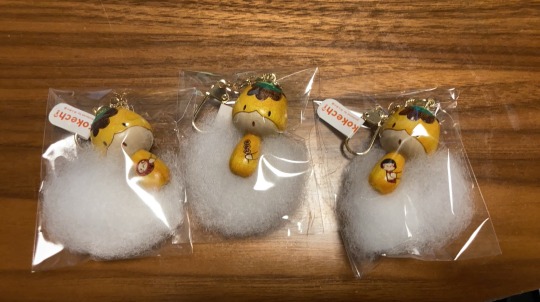
my favorite!
1 note
·
View note
Text
#Toyota#Subaru#electric cars#cooperation#development#all-electric sport utility vehicle#Japanese market#North America#EV operations#President Koji Sato#bZ4X#Solterra#production#Gunma Prefecture#collaboration#product lineups#investment
0 notes
Text






Capítulo 1 introducción: Sean bienvenidos japonistasarqueológicos a una nueva entrega, de arqueología nipona en esta ocasión vamos a presentar a uno de los arqueólogos japoneses más notables se llama Tadahiro Aizawa ¿Quién fue? Y ¿Qué aportó a la ciencia arqueológica? Dicho esto pónganse cómodos que empezamos. - Tadahiro Aizawa nació el 21 de junio durante la era Taisho (1912-1926), nació en el distrito de Ebana en Tokio, desde la temprana edad de los 8 años ya tenía interés por las reliquias antiguas, a los 9 años de edad sus padres se habían divorciado en los años 30. A la edad de 11 se mudó a la ciudad de Kiryu, Gunma, en 1938 a la edad de 12 años ingresó a la Escuela nocturna Shotoku Jinjo de la ciudad de Tokio durante esa fecha japón estaba en plena guerra contra china en la llamada guerra sino-japonesa, cabe destacar que la era showa empezó en 1926 y terminó en la de década de los 80. - Espero que os haya gustado esta presentación y viene de camino los capítulos 3 y 4 de la serie japón en su arqueología poco a poco lo iré trayendo que pasen una buena semana y nos vemos en próximas publicaciones de historia y arqueología nipona. - Un cordial saludo. - 第 1 章の紹��: 日本考古学の新しい記事へようこそ考古学者、今回は最も注目すべき日本の考古学者の 1 人、彼の名前は相沢忠宏. 彼は誰だった?そして、彼は考古学に何を貢献したのでしょうか?そうは言っても、気楽に始めましょう。 - 相沢忠宏は大正時代(1912-1926)の6月21日に生まれ、東京の江花地区で生まれ、8歳の頃からすでに古代の遺物に興味を持っていました. 1930年代に離婚。 11 歳のときに群馬県桐生市に移り、1938 年に 12 歳のときに東京市の聖徳尋常夜学校に入学しました。その日、日本はいわゆる清戦争で中国と戦争をしていました。 -日本人は、昭和が1926年に始まり、1980年代に終わったことに注意する必要があります. - このプレゼンテーションと考古学における日本シリーズの第 3 章と第 4 章が進行中であることを願っています。少しずつお届けします。良い週をお過ごしください。また、日本の歴史と考古学の今後の出版物でお会いしましょう。 - 心のこもった挨拶。 - Chapter 1 introduction: Welcome archaeologists to a new installment, of Japanese archaeology, this time we are going to present one of the most notable Japanese archaeologists, his name is Tadahiro Aizawa. Who was he? And what did he contribute to archaeological science? With that said, make yourselves comfortable, let's get started. - Tadahiro Aizawa was born on June 21 during the Taisho era (1912-1926), he was born in the Ebana district of Tokyo, from the early age of 8 he already had an interest in ancient relics, at the age of 9 his parents they had divorced in the 1930s. At the age of 11 he moved to the city of Kiryu, Gunma, in 1938 at the age of 12 he entered the Shotoku Jinjo Night School in the city of Tokyo during that date Japan was at war against China in the so-called Sino War -Japanese, it should be noted that the showa era began in 1926 and ended in the 1980s. - I hope you liked this presentation and chapters 3 and 4 of the series Japan in its archeology are on the way, little by little I will bring it, have a good week and see you in future publications of Japanese history and archaeology. - A cordial greeting.
#日本#文化#写真#歴史#先史時代#群馬#県#地理#ユネスコ#相沢忠弘#考古学#Japan#culture#photos#history#prehistory#Gunma#prefecture#geography#unesco#TadahiroAizawa#archaeology
50 notes
·
View notes
Text












町田啓太 ファースト写真集 BASIC Machida Keita First Photobook: BASIC (2019)
Behind the Scene DVD - Part 3 / 4
#machida keita#machida keita photobook#photography#no edits#mkb2019#this part is about his childhood back at gunma prefecture
11 notes
·
View notes
Text





2025.01.05 谷川岳 Mt.Tanigawa. snow mountain.
119 notes
·
View notes
Text




群馬・伊香保神社 ∣ Ikaho Shrine・Gunma (2) (3) (4) by Iyhon Chiu
7 notes
·
View notes
Text
群馬県
Japanese Prefectures: Kantō - Gunma
都道府県 (とどうふけん) - Prefectures of Japan
Learning the kanji and a little bit about each of Japan’s 47 prefectures!
Kanji・漢字
群 む(れる)、むら、グン flock, group, crowd, herd, swarm, cluster
馬 うま、ま、バ horse
県 ケン prefecture
関東 かんとう Kanto, region consisting of Tokyo and surrounding prefectures
Prefectural Capital (県庁所在地) : Maebashi (前橋市)

The ancient province of Gunma was a center of horse breeding and trading activities, and thus the character for horse is one of the kanji in the prefecture's name. The horse came to Japan along with the arrival of a large migration of people from the mainland of Asia, and from then on the horse became a vital part of the Japanese military and displaced the older Yayoi tradition of fighting on foot.
One of only eight land-locked prefectures in Japan, Gunma is also very mountainous. Snowy mountains that are prime for winter sports give way to excellent hiking trails in the summer. Gunma has some of the nation's best hot springs and is famous for its daruma dolls, which are good luck charms. Other sports to do in Gunma include canyoning, waterfall sliding, rafting, and bungee jumping.
Recommended Tourist Spot・おすすめ観光スポット Sainokawara Park - 西の河原公園
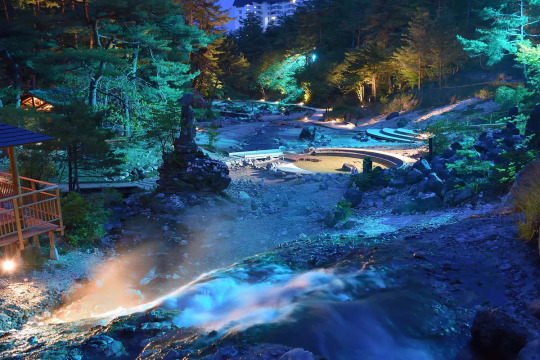
Sainokawara Park at night
Sainokawara Park is in a valley just outside of the hot spring and ski resort town center of Kusatsu, where several hot spring sources and a large outdoor bath are located. There are walking trails around the upper part of the park that lead through the magnificent natural landscapes. This is the most active hot spring area in Japan, with an output of hot spring water of 1,070 litres per minute. Hot spring water can be seen bubbling to the surface in certain places, where they collect into hot water pools and run down the valley in warm streams before joining the central mountain stream. There is also a hot water waterfall with a free foot bath at the base. The park area is accessible free of charge.
Due to the high temperature of the hot spring waters that flow here, very little can grow in the areas where it collects. It was believed that the spirits of children who died before their parents would be sent to these barren pools. You may come across small stone statues called jizo, that are made in the image of the guardian deity of children and travelers, Jizo Bosatsu. These statues often are wearing red hats and bibs, and are meant to protect the spirits of the children from demons.
The natural pools in the park are not for bathing, but the park also houses the Sainokawara Rotenburo, a large open-air public bath with two gender-separated outdoor hot springs, with a capacity of 100 bathers each. The outdoor bath also offers an evening of mixed bathing every Friday, when the bath is open to everyone, including couples and families.

Yubatake, or Hot Water Field, in Kusatsu
A 10-minute walk from Sainokawara Park is the Yubatake (or "Hot Water Field"). Here in the center of Kusatsu is a field of pumps that removes 32,300 litres of hot water every minute, cools it a few degrees, then sends it off to various local hot springs. The healing waters of the Kusatsu Onsen (hot springs) vary from milky to clear, and sulfurous to acidic, and are said to soothe most of your troubles, except a broken heart.
Regional Cuisine - 郷土料理 Yakimanju - 焼きまんじゅう

Yakimanju (source)
Yakimanju is a popular snack in Gunma Prefecture, but is not well known outside of the prefecture. Yakimanju is a grilled sweet bun. Manju are sweet buns made of rice or wheat flour and commonly are steamed. Yakimanju is grilled after being steamed, giving the outside a crunchy texture rather than the usual fluffy texture. The outside is coated with a sweet mixture of brown sugar, syrup, and miso paste. Unlike manju, which usually has a filling of red bean or other sweet paste, yakimanju typically has no filling.
Yakimanju was invented at the end of the Edo period, about 150 years ago. Wheat was commonly grown in agricultural Gunma, and thus wheat flour was originally used to make the predecessor of yakimanju, called sakamanju. Sakamanju hardened quickly after being made, and so to make it easier to eat, people would grill it and season it with miso paste. And thus yakimanju was developed.
Gunma Dialect・Gunma-ben・群馬弁
1. あーね aa-ne oh really?, I see, etc. (aizuchi*)
「あーね」 (aa-ne)
Standard Japanese: 「そうなんだ」 (sou nan da)
English: "Oh, really?"
Note: If you use it too much, the other person will get irritated
*aizuchi (相槌): backchanneling, interjections during conversations that show you are paying attention
2. ~がね、~がん ~ga ne, ~gan isn't it, don't you think, right (ends a sentence)
「宿題やるって言ったがね!」 (shukudai yaru tte itta ga ne!)
Standard Japanese: 「宿題やるって言ったじゃん!」 (shukudai yaru tte itta jan!)
English: "I said do you do your homework didn't I!"
3. じゅーく juu-ku impertinent
「じゅーくこくな!」 (juu-ku koku na!)
Standard Japanese: 「生意気なことを言うな!」 (namaiki na koto o iu na!)
English: "Don't be cheeky!"
4. 世話ねえ sewa nee "no problem" or "too much of a bother"
「世話ねえ」 (sewa nee)
Standard Japanese: 「問題ない」 (mondai nai) OR 「手に負えない」 (te ni oenai)
English: "No problem" OR "That's too much of a bother"
5. ~だんべえ ~danbee right, isn't it, etc. (sentence ending)
A: 「焼きまんじゅうって美味しいね。」 (yakimanju tte oishii ne) B: 「そうだんべえ。」 (sou danbee)
Standard Japanese: A: 「焼きまんじゅうって美味しいね。」 (yakimanju tte oishii ne) B: 「そうだろ。」 (sou daro)
English: A: "Yakimanju is delicious, isn't it?" B: "That's right"
6. てんで tende very
うちの孫は、てんでかわいいよ~ (uchi no mago wa, tende kawaii yo~)
Standard Japanese: うちの孫、とてもかわいいよ~ (uchi no mago, totemo kawaii yo~)
English: Our grandson is so cute!
More Gunma dialect here (Japanese page)
#japanese prefectures#日本語#japanese#japanese language#japanese langblr#langblr#studyblr#都道府県#群馬県#gunma
30 notes
·
View notes
Text

#4k#Flag of Gunma#Japanese prefectures#3d Gunma flag#Japan#Gunma flag#3d texture#Day of Gunma#Japanese national symbols#3d art#Gunma#wallpapers
0 notes
Text
ピットクン(群馬県)

ピットクンは、こくみん共済 coop(全国労働者共済生活協同組合連合会)のマスコットキャラクターです。ピンク色で丸い体に、大きな目と口が特徴的です。coopの「co(協同)」と「op(協力)」の意味を��現するように、みんなで力を合わせて支え合うことを表現しています。ピットクンは、coopのPRキャラクターとして、ポスターやパンフレットなどに登場。親しみやすいデザインで、幅広い世代に共済の必要性や大切さを伝える役割を担っています。
手抜きイラスト集
#ピットクン(群馬県)#Pitkun (Gunma Prefecture)#Pitkun (Prefettura di Gunma)#Pitkun (Prefectura de Gunma)#Pitkun (Präfektur Gunma)#Pitkun (préfecture de Gunma)#手抜きイラスト#Japonais#bearbench#art#artwork#illustration#painting
1 note
·
View note
Text

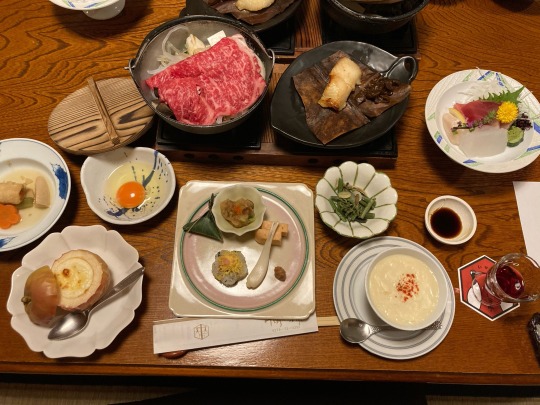
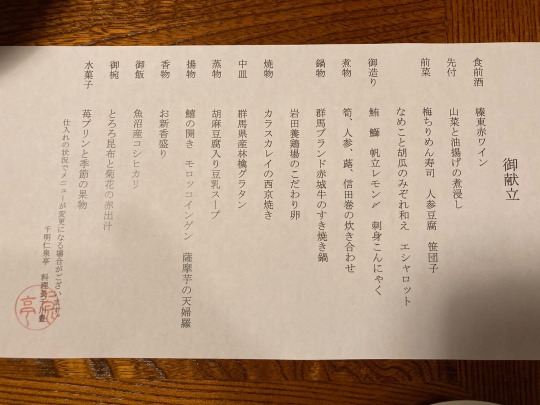
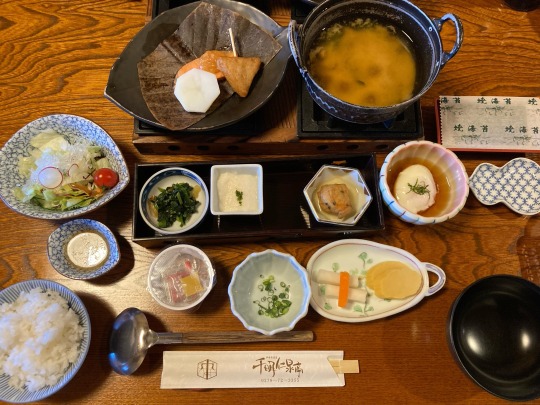

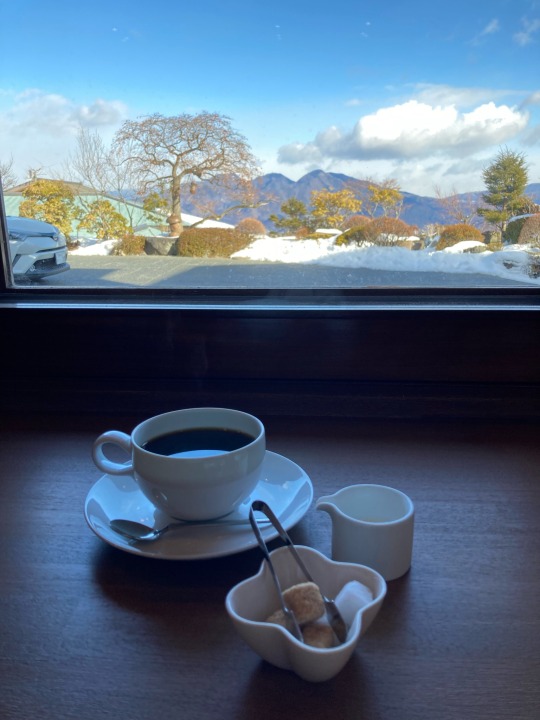
0 notes